The Martinshof Story - Page 10
Page | Previous |
Next ||
1 |
2 |
3 |
4 |
5 |
6 |
7 |
8 |
9 |
10 |
11 |
12 |
13 |
14 |
15 |
16 |
? |
Next -
Previous -
Top -
Page 1 -
Photos -
Michael's Blog -
Jazclass Links
36. How the hell can I do this ?
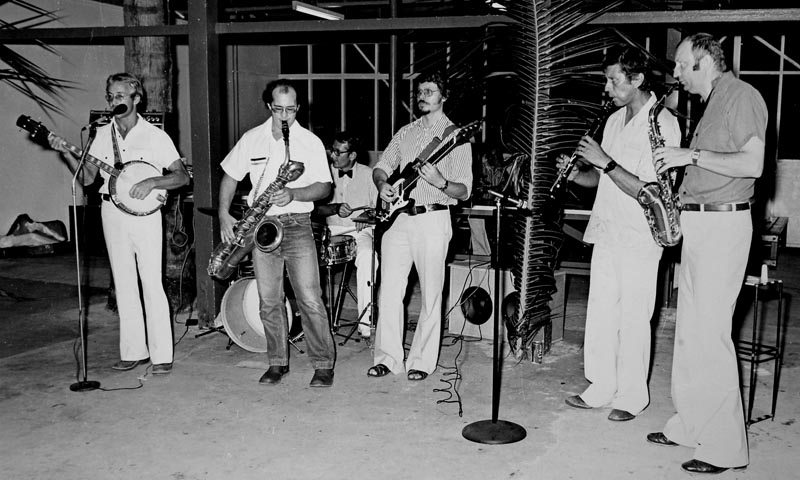 By 1979 I had, emotionally (while working at the Bougainville Copper mine) reached the
end of the line. I had moved from one job to the next for 14 years to find a place
where I could truly express myself, but, apart from a few short periods, I never
realised this ambition. As a result I was not just frustrated, but depressed
beyond belief.
By 1979 I had, emotionally (while working at the Bougainville Copper mine) reached the
end of the line. I had moved from one job to the next for 14 years to find a place
where I could truly express myself, but, apart from a few short periods, I never
realised this ambition. As a result I was not just frustrated, but depressed
beyond belief.
An attractive (and nice) woman came along and took me
temporarily away from my misery, but she was a catalyst, rather than a cure, so by 1980
I was alone (having left my dear wife, children and girlfriend), living in
Adelaide in emotional tatters.
At the end of the year I felt I might as well do the
whole monthy : quit my job as a Senior Geological Consultant with a large mining
company (WMC) in Adelaide, and start studying music, the only thing I had really enjoyed doing
while on Bougainville Island.
 This was the emotional state I was in when a phone call from my mother, in the middle
of the night, informed me of my father's unexpected death. I rang my brother
Claus and we were on our way on the next available flight to Holland.
This was the emotional state I was in when a phone call from my mother, in the middle
of the night, informed me of my father's unexpected death. I rang my brother
Claus and we were on our way on the next available flight to Holland.
So how did I feel? I truly felt emotionally like a house burnt down, with only
the walls standing (I had seen many of these in Germany at the end of the war).
But I also felt that I owed my father a great depth. Throughout the years he
had, regardless of his sometimes difficult circumstances, continued to provide for me
financially while I was studying geology (very much at my leisure). So this was for me
the time to pay him back. He never ever mentioned a word to me about this during his
life, but I knew that this was something he hoped I would do for him if the occasion
would ever arise. To look after my mother and sell the business with personnel in
tact. So I did my level best, and, against considerable odds, managed to succeed.
 Throughout this, almost nightmare, scenario I was especially helped by three people : a
Mr. Jansen, then bank manager of one of the regional Slavenburgse banks, who
gave me accurate and timely advise of my course of action, Mrs. de Jonge, our Senior bookkeeper, who had all the
financial and personal aspects of our company at her fingertips and with whom I
discussed everything that had to be done.
Throughout this, almost nightmare, scenario I was especially helped by three people : a
Mr. Jansen, then bank manager of one of the regional Slavenburgse banks, who
gave me accurate and timely advise of my course of action, Mrs. de Jonge, our Senior bookkeeper, who had all the
financial and personal aspects of our company at her fingertips and with whom I
discussed everything that had to be done.
Last but not least Jan Klein
Hesselink, the publican of Cafe Beuse (and perhaps one of my dearest friends
ever), where I nightly (over quite a few beers) debriefed myself, and who's understanding silences
and occasional quiet encouraging words kept me going and eventually succeed.
Next -
Previous -
Top -
Page 1 -
Photos -
Michael's Blog -
Jazclass Links
37. Heading towards a brick wall
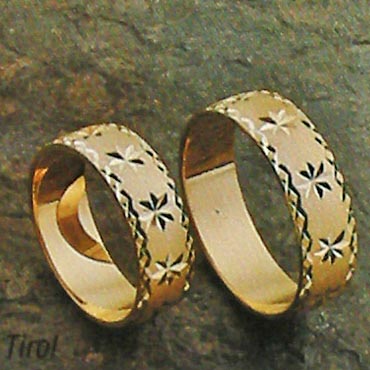 It was mid 1981 and the recession started to bite. Interest rates surged upwards and
many companies, retailers, wholesalers, manufacturers, but especially jewelers and
farmers went bankrupt. They had borrowed too much money for its tax advantage but now
were facing interest bills which they were not possibly able to pay.
It was mid 1981 and the recession started to bite. Interest rates surged upwards and
many companies, retailers, wholesalers, manufacturers, but especially jewelers and
farmers went bankrupt. They had borrowed too much money for its tax advantage but now
were facing interest bills which they were not possibly able to pay.
My bank manager
Mr.Jansen, who also was a Director of our company, experienced such tragic dramas at
his office every week and was quick to point this danger out to me.
I had asked him to
come and advise me every month which he did, after all it was in his bank's
interest too. (We had a 600,000 guilders overdraft facility with the bank, but owed them already 800,000 by the time I took over. Rapidly this debt would climb much higher, with our interest payments equaling the size of previous year's entire nett profit!)
Martinshof's sales had been going down throughout the first half of 1981 and
our market share had dipped well below 10% (way below its heyday peak of 15%) and was
heading towards 5%.
My father had put a new lass (Irma) on a 3 months trial contract which was due
for renewal. "You must let her go Mr.Furstner. You can still do
it now, in a month time it will be too late", Jansen urged me on and I did,
causing considerable upheaval amongst our personnel.
"Work out
a detailed estimate of your costs and earnings for next year", he also told me,
"then decide what you are going to do about it."
The very first day (after my father's death) when I walked towards the Martinshof
office and opened its door, all staff were looking at me astonished as if they had
heard a ghost. My footsteps had sounded exactly the same as my late father's. This
similarity probably helped a lot in establishing trust with my personnel, but I
realised, after the incident about Irma, that trust alone was not enough. There had to
be understanding and involvement too.
So I immediately started regular staff meetings once a month. These were usually held
on a Friday after work outside on our terrace or inside in our lounge. These were
always pleasant occasions where I explained the current situation and answered
questions, while we consumed aperitifs, wine and tasty hors d'oeuvre platters from a
restaurant in the village.
This proved to be most useful, for as the business situation rapidly grew worse we felt
we were all in it together, enabling us to jump over that deadly brick wall rushing
towards us, just in time to survive.
Next -
Previous -
Top -
Page 1 -
Photos -
Michael's Blog -
Jazclass Links
38. The roller coaster ride of the Gold price
 To understand the business conditions at the time it is important to know what happened
to the Gold price in 1980-83.
To understand the business conditions at the time it is important to know what happened
to the Gold price in 1980-83.
For many years the price of gold was set at the fixed rate of US$35 per ounce. By the
1960s however this valuation made it economically impossible to dig the gold out off the
ground, certainly in most areas in Australia.
Many formerly flourishing gold
mining towns in Western Australia were struggling to survive and several of them
were abandoned and became ghost towns.
Kalgoorlie too, which had sprung up after Paddy Hannan's discovery of the Golden
Mile there in 1893, was now going through hard times.
The main company there,
Western Mining Corporation (WMC) was almost out off money, but at a crucial management
meeting Roy Woodall, their chief geologist, talked the management into drilling
just one more exploration hole at Kambalda (50km to the South).
Miraculously it
struck gold! Or rather not gold at all but precious nickel.
Instantly exploration companies from all over the world rushed to Kalgoorlie and
started exploring. I too went there in 1968, although offered a position with Roy I
joined Selection Trust (an English company mining diamonds in Africa). They had not
discovered anything yet and I found that more interesting. Gold however remained
a dirty word amongst all us explorers at the time.
The big break through came a few years later however as a result of the oil
embargo when financial systems throughout the world came under considerable stress,
so it was decided to float the gold price.The graph below shows what happened.
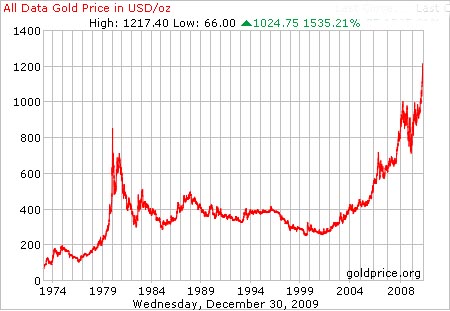
After initially moving up rather hesitatingly around 1974-79, it suddenly shot up in
1980 to over US$800 an ounce, moved erratically up and down for a year, then plunged
down to US$350 in mid 1982, after which it more or less stabilised around the US$400 mark,
until it increased again as a result of the Global Financial Crisis these last few
years.
I therefore happened to be running Martinshof during the most volatile and highest
gold prices period for around 30 years. It sure was a roller coaster ride which
forced all of us in the industry (jewelers, wholesalers and manufacturers) to dramatically
change our ways and take strong decisive action. It would change the jewelry industry
forever. The Golden age of precious metal jewelry of the 1950 and 60s had ended abruptly
and probably forever.
Next -
Previous -
Top -
Page 1 -
Photos -
Michael's Blog -
Jazclass Links
39. A struggle to survive cut throat competition
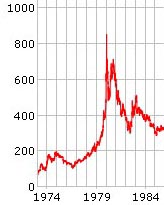 In 1980 most gold jewelry, especially wedding rings priced themselves out off contention almost overnight. With a sudden 4 to 5 fold increase of the gold price the heavy ring models simply became too dear for most of the general public. Something had to be done and quickly.
In 1980 most gold jewelry, especially wedding rings priced themselves out off contention almost overnight. With a sudden 4 to 5 fold increase of the gold price the heavy ring models simply became too dear for most of the general public. Something had to be done and quickly.
Niessing (like other manufacturers) reacted instantly designing an entirely new collection of much lighter ring models which became available quite soon after.
The big problem however were the jewelers which were still fully stocked up with heavy unsalable rings.
Instead of sticking together and following one uniform policy, the wholesalers started a fearce cut throat campaign against each other, offering to buy up a competitor's products and exchange it for their own new models at an attractive price, intending to change the (jeweler) customer over to their side this way.
My two sales representatives on the road, Marion Turney and Cees van Overbeeke were constantly under pressure by jewelers to give them a good deal for their old stock. In many cases this meant paying considerably more for these rings than we had charged the jeweler when he purchased the rings initially.
We did what we could, but nevertheless lost some customers to other wholesalers, especially of course to the all powerful, market dominating Desiree.
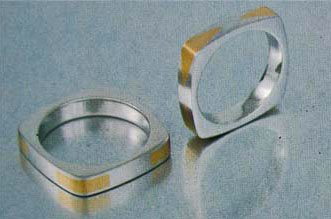 The combined effect of sky high gold prices and high interest rates created yet another problem for jewelers. They were no longer in a position to hold large quantities of stock.
The combined effect of sky high gold prices and high interest rates created yet another problem for jewelers. They were no longer in a position to hold large quantities of stock.
Niessing therefore produced a large catalogue with outstanding photographs of their entire new collection, so that prospective customers could select a ring from leafing through the catalogue.
Desiree published a beautiful brochure, and I was under continous pressure from Marion to publish one too, but how to get this done in an affordable way ?
Several wholesalers resorted to the production and distribution of dummies (look alike models made of cheap material), but I (as well as Niessing) did not wish to go this way with the Martinshof collection. I gave in in the end I believe with some dummies for the Holiday range.
Next
Copyright © 2010 Michael Furstner






 In 1980 most gold jewelry, especially wedding rings priced themselves out off contention almost overnight. With a sudden 4 to 5 fold increase of the gold price the heavy ring models simply became too dear for most of the general public. Something had to be done and quickly.
In 1980 most gold jewelry, especially wedding rings priced themselves out off contention almost overnight. With a sudden 4 to 5 fold increase of the gold price the heavy ring models simply became too dear for most of the general public. Something had to be done and quickly. The combined effect of sky high gold prices and high interest rates created yet another problem for jewelers. They were no longer in a position to hold large quantities of stock.
The combined effect of sky high gold prices and high interest rates created yet another problem for jewelers. They were no longer in a position to hold large quantities of stock.